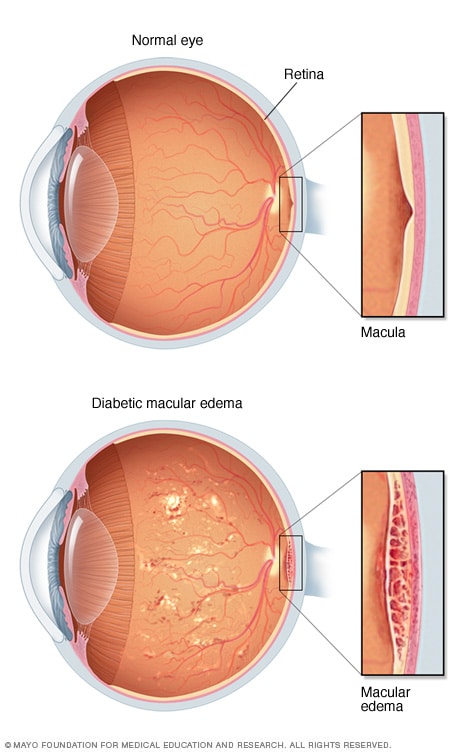What is diabetic macular edema?
Diabetic macular edema is an eye condition that can happen due to diabetes. If left untreated, it may lead to vision problems or even blindness.
Diabetic macular edema is swelling in the central part of the eye's retina called the macula. This condition happens in some people who have diabetes.
The retina is a thin layer of tissue that lines the back inner wall of the eye. Containing millions of light-sensitive cells, the retina works like a camera — receiving, organizing and sending information to the brain so that you can see. The macula is a region near the center of the retina that allows you to see objects in sharp detail. Swelling, also called edema, in the macula can cause vision problems and may lead to blindness.
The connection to diabetic retinopathy
Diabetic macular edema

Diabetic macular edema
In people with diabetes, too much blood sugar can damage the tiny blood vessels at the back inner wall of the eye, called the retina, or block those vessels completely. This condition is diabetic retinopathy. Tiny bulges, called microaneurysms, form in the blood vessels, leaking fluid into the retina. The fluid can cause swelling in a part of the retina called the macula. This serious eye problem is diabetic macular edema. It can cause vision problems or blindness.
Diabetic macular edema happens as a result of another eye condition that can develop in people with diabetes called diabetic retinopathy. In healthy eyes, cells in blood vessels, called endothelial cells, make a barrier between the macula and the blood vessels that bring nutrients to the retina. In people with diabetes, high blood sugar can trigger problems that damage the endothelial cells. Diabetes also may lead to the blockage of retinal blood vessels. When the retina becomes damaged in this way, the condition is known as diabetic retinopathy.
There are two main types of diabetic retinopathy. Diabetic macular edema can develop with either type at any stage of the disease. But the more severe diabetic retinopathy becomes, the more likely diabetic macular edema is to develop.
- Nonproliferative diabetic retinopathy. In this type of diabetic retinopathy, the weakened blood vessels in the retina form tiny bulges, called microaneurysms. The blood vessels also may become blocked. That keeps areas of the retina from getting oxygen and nourishment. This type of diabetic retinopathy can be mild, moderate or severe, depending on the amount of damage to the blood vessels. It doesn't always require treatment.
- Proliferative diabetic retinopathy. In this type of diabetic retinopathy, when areas of the retina can't get oxygen and nourishment, new blood vessels grow. Typically, those new blood vessels are fragile. They may bleed, and they can leak fluid into the center of the eye. Eventually, they may cause the retina to separate from the inside wall of the eye. Proliferative diabetic retinopathy can cause blindness if it is not treated.
Many people with diabetes eventually develop some form of diabetic retinopathy. Most retinopathy is mild, and it doesn't threaten vision. But it's important to be aware of the possible eye problems diabetes can cause. If you have diabetes, get an eye exam at least once a year. During the exam, your provider can dilate your eyes or use retinal photography to get a close look at your retina.
If you notice any problems with your vision, especially blurred vision, tell your health care provider right away.
Feb. 28, 2023
- Vision loss and diabetes. American Diabetes Association. https://diabetes.org/diabetes/eye-health/vision-loss-diabetes. Accessed Jan. 23, 2023.
- Diabetic macular edema. American Academy of Ophthalmology. https://eyewiki.org/Diabetic_Macular_Edema. Accessed Jan. 23, 2023.
- Fraser CE, et al. Diabetic retinopathy: Classification and clinical features. https://www.uptodate.com/contents/search. Accessed Jan. 23, 2023.
- Riordan-Eva P, et al., eds. Retina and retinal disorders. In: Vaughan & Ashbury's General Ophthalmology. 19th ed. McGraw Hill; 2018. https://accessmedicine.mhmedical.com. Accessed Jan. 23, 2023.
- Get a dilated eye exam. National Eye Institute. https://www.nei.nih.gov/healthyeyes/eyeexam. Accessed Jan. 24, 2023.
- Elsevier Point of Care. Clinical Overview: Diabetic retinopathy. https://www.clinicalkey.com. Accessed Jan. 24, 2023.